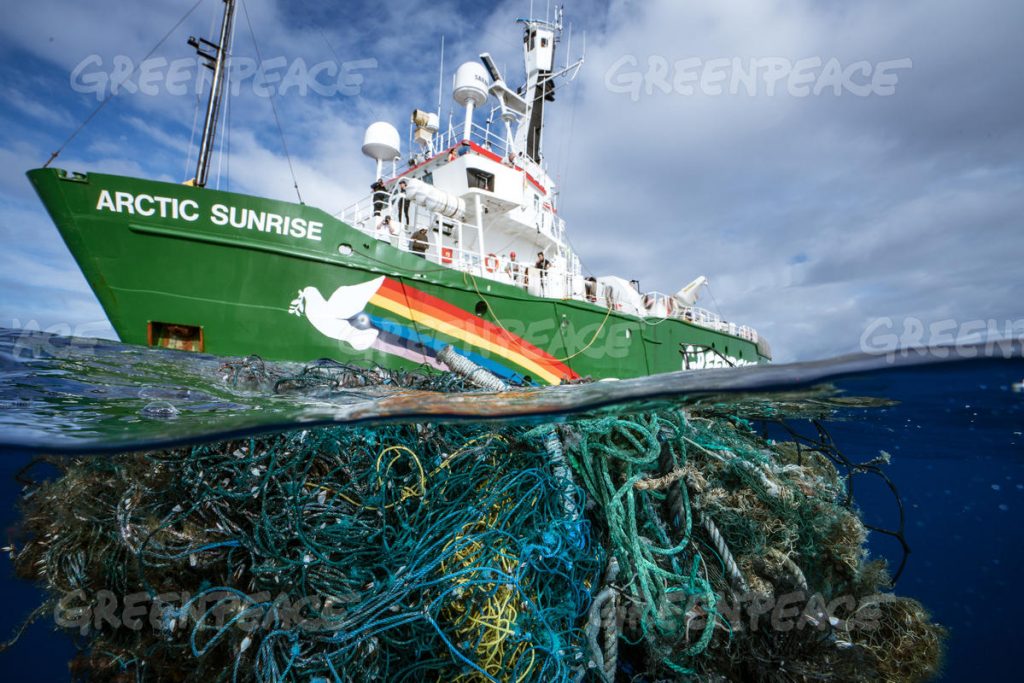Great Pacific Garbage Patch Expedition Reveals ‘Plastic Soup’

Debris from a fishing net seen underwater with MY Arctic Sunrise ship in background. The crew of the Greenpeace ship MY Arctic Sunrise voyage into the Great Pacific Garbage Patch documenting plastics and other marine debris. The Great Pacific Garbage Patch is a soupy mix of plastics and microplastics, now twice the size of Texas, in the middle of the North Pacific Ocean. PC: © Justin Hofman / Greenpeace
Greenpeace concluded an expedition to the Great Pacific Garbage Patch this month, finding 11 times more microplastic pollution in the gyre than in its prior sampling off the coast of major U.S. cities like Los Angeles, New York, Miami, San Francisco and San Diego.
The organization also removed and identified several pieces of branded plastic trash, though the vast majority of the garbage patch is more like a soup full of plastics and microplastics.
“It’s clear that we can’t just clean up all of the plastic in our oceans,” said Greenpeace Oceans Campaigner David Pinsky, who was aboard the Arctic Sunrise for its expedition. “While we frequently saw larger plastic debris, from bottles and fishing nets to bags and toothbrushes, the most numerous types of plastic we encountered were tiny microplastics that were pulled up by the hundreds using a special manta net alongside the ship. Corporations must be held accountable for this mess.”
Greenpeace found an average of 508 microplastics in the samples it collected in the garbage patch utilizing a 5 Gyres manta trawl net. The organization also collected 50 water samples, which will be tested for plastic microfibers by Scripps Institution of Oceanography.
Though it can be difficult to identify the sources of plastic pollution in the ocean, the organization audited branded plastic it removed from the garbage patch whenever possible. Coca-Cola, Letica, Pennzoil, Schick, Unilever (UK and Netherlands), Bayer (Germany), Cloralex (Mexico), Kao Bleach (Singapore), Chinese Petroleum Corp. (which in 2007 changed its name to CPC, based in Taiwan, meaning the bottle Greenpeace found may have been manufactured more than 11 years ago), and Chinese brands Wahaha and Kang Shi Fu were among some of larger brands found in the gyre. Coca-Cola and Unilever were also two of the top ten brands identified in Break Free From Plastic cleanups and brand audits spanning six continents earlier this month. Coca-Cola was the worst corporate plastic polluter, found in 40 of 42 countries overall. Greenpeace found a Coca-Cola bottle from China, produced more than 1,000 miles from where it was found in the garbage patch.
“There is no such thing as ‘throwing away’ plastic,” Pinsky continued. “The vast majority of it is not recycled. It’s ending up in our oceans, waterways and communities around the world. Plastic doesn’t ever go away, it just fragments into microplastics that continue polluting our world for decades to come.”
Greenpeace’s expedition to the garbage patch coincided with The Ocean Cleanup’s effort to remove plastic pollution from the surface of the ocean gyre. While the effort could succeed in removing some plastic, the vast majority exists in the form of microplastics or sinks to the ocean floor, and more plastic is always entering the oceans. Cleanup proposals could also harm wildlife that get entangled in plastic. Greenpeace is urging corporations to reduce and eventually phase out their reliance on single-use plastics instead.
Greenpeace’s Arctic Sunrise ship is currently in Honolulu. While in Hawai‘i, Greenpeace will partner with the Protect Kaho‘olawe ‘Ohana and Kaho‘olawe Island Reserve Commission to hold a beach cleanup and brand audit at the sacred island of Kaho‘olawe to help identify the corporations most responsible for branded single-use plastic pollution in the region.









